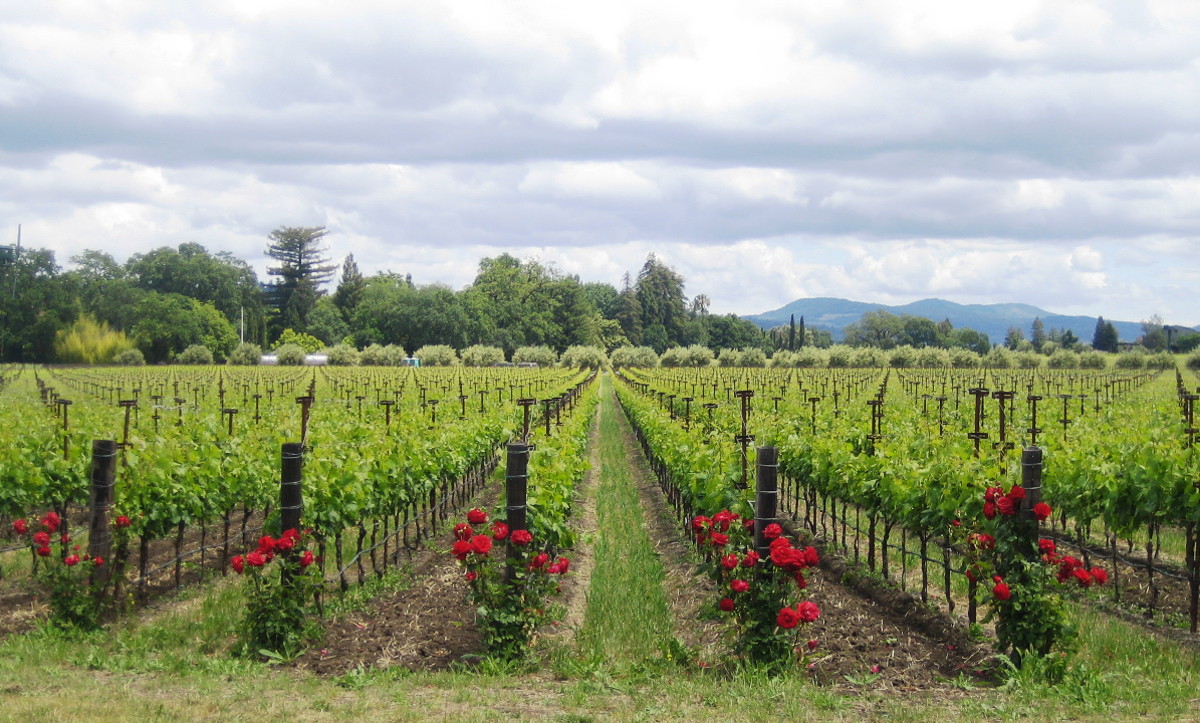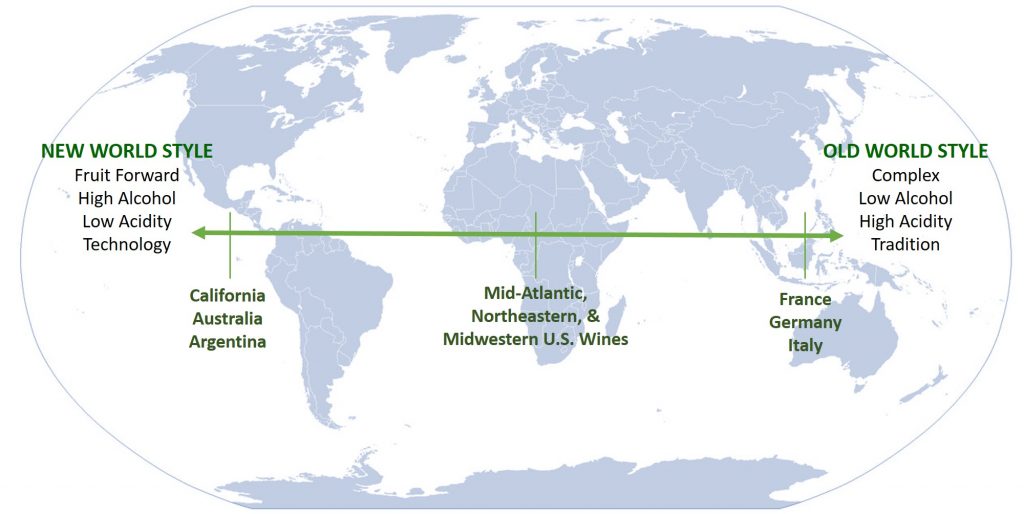Old World vs. New World Wine
One of the first classifications that a wine expert will use to differentiate a wine is to determine if it is Old World or New World in origin.
Old World classification pertains to wines that are produced in traditional, European countries like France, Italy, and Spain. Wines typically contain the following characteristics:
- Lower alcohol
- Higher acidity
- Greater emphasis on complexity
- Production is based on tradition
- Often regionally designated
In contrast, New World wines are typically produced in newer, younger wine regions like the United States and Australia. Wines from these countries contain the following commonalities:
- Higher alcohol
- Lower acidity
- Greater emphasis on fruit forward nature
- Production is based on science and technology
- Often designated by grape variety

Are Eastern Wines New World in Style?

My tasting experience with Midwestern and Eastern U.S. wines often left me pondering to which of these two distinctions the wines belonged. By location, wines produced in the U.S. are considered “New World.” Rarely, however, are Eastern U.S. wines reflective of wines produced in Western states. For this article, I’m using the term “Eastern” in a broad sense to include all states east of the Rocky Mountains.
Over time, I’ve deduced that most wines produced in the U.S., but outside of the largest three Western wine-producing states (i.e., California, Oregon and Washington), belong somewhere between the Old and New World classifications. In my time with international wine consultants, many comment on the degree of concentration that Eastern U.S. wines have. Their perspective in concentration, especially among red wines, is quite opposite feedback compared to many perspectives affiliated with Western U.S. experts.
For example, in comparing many Pennsylvania grown and produced Cabernet Franc wines, they often exude a delicate balance of dried herb, tobacco, red fruit, and deeply floral (e.g., lavender, violets, perfume) aromas. In comparison to many wines from the Loire (France), the intensity of red fruit, red berries, strawberries, cherries, and floral undertones exceeds in level. However, in comparison to Cabernet Franc or Cabernet Sauvignon produced in California, the intensity of these fruity, floral tones often appears dilute.
Additionally, the acidity often lies somewhere between these two classic extremes. While many premium producers are getting more comfortable with acid manipulation, the overall acidity tastes lower than many of Old World wines distributed to the U.S.
These same comparisons can be made with many white Vitis vinifera varieties, as well.
It should be noted that there are exceptions to this observation. Through some of my tastings, I’ve found it more challenging to differentiate wines produced in the Eastern U.S. when tasted against both Old World and New World comparisons. This may be related to wine production restraints in New World regions (i.e., earlier harvests to reduce alcohol, acid additions to manipulate the wine’s acidity, etc.). Proper site selection and/or increased growing time among Eastern producers can also sway many wines to have a New World essence. In comparison, the integration of technology in some Old World regions and variability in blending can alter sensory perceptions. Or, variable harvest years can influence the concentration and depth of wines produced in the Eastern U.S.
What Does this Mean for Winemakers?
Therefore, I like to think of Old World and New World styles on a continuous spectrum as opposed to an either-or situation.
Determining where your V. vinifera wines fall on the Old World – New World spectrum can help define future wine processing plans.
For example, if you find your wines are more consistently Old World in style, we can discuss altering processing strategies to push certain wines into more of a New World style. Alterations are always specific to a client’s goals, brand identity, and production limitations. These strategies could include:
- Developing harvest parameters
- Making acid alterations
- Introducing enological products to emphasize specific sensory attributes
- Blending with riper varieties
- Integrating use of available technology
In contrast, if developing a wine that more Old World in style is in the winery’s interest, we can also work together to refine processing strategies. Again, these alterations and objectives are unique to each winery. Such strategies could include:
- Tasting benchmark producers of a particular style
- Evaluating harvest parameters
- Refining the winemaking process
- Integrating Old World winemaking techniques
Things I’ve Learned in Discussing Eastern U.S. Wines
I think that wines from these regions have a unique marketing niche.
In an essence, wines produced from Eastern U.S. regions have the ability to take on positive characteristics from both Old and New World wine styles. What does this mean from a marketing perspective?
- Educating consumers is helpful. My experiences have taught me that many consumers do not know why a Cabernet Sauvignon or a Chardonnay tastes so different between those produced in California versus, say, Pennsylvania. In the past, I’ve used graphics to show the wide range of flavors associated with common Vitis vinifera wines. Many consumers appear open to this concept, and more accepting of a change, when they know they aren’t being tricked.
- When in doubt, pair the wines with food. Or provide food options that will go well with the wine. Paint a picture in the consumer’s mind of where this wine will work. All of my best Eastern wine “conversions” have been over food. It’s okay to get creative here. If you need help going beyond “this red wine pairs well with steak,” don’t be afraid to use past blog posts or my Instagram pairings. I’m also available to consult on this topic.
Many Eastern wines pair very well with foods. Offering unique food-and-wine pairings can attract consumers that may otherwise be wearing of trying regional wines. by: Bartlett Pair Photography - Make sure your wines reflect what you are selling. One example that I often witness confusing to consumers is when they share “their version of White Zin.” Having worked in Napa Valley for a few years, I have to admit, these versions rarely remind me of my past times tasting White Zin. I’m not saying this sales tactic doesn’t work some of the time. However, I do think it’s important that tasting room employees know what it is you’re selling to avoid confusing consumers further. Consumers often have clear (though, poorly communicated) perceptions of what they like or are used to drinking when it comes to wine.
The styles of wine produced in the Eastern U.S. are different, and to some degree, unique.
How do you walk away with knowing the style of wines you’re selling? A good place to start is tasting and classifying your wines along the Old World – New World Spectrum. However, it takes some experience and wine regions and style education to really know where wines are likely placed. It’s an opportunity where Denise Gardner Winemaking can work with you to determine where your fall on the spectrum and define where you want your wines to go to align more cohesively with your sales techniques.


